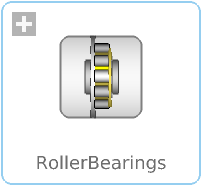WOLFRAM SYSTEM MODELER
RollerBearingsPackage containing classes related to roller bearings |
|
Package Contents
|
Roller bearing possible to parameterize with values corresponding |
|
|
Roller bearing parameterized with values corresponding to SKF NU_306_ECP |
|
|
Roller bearing parameterized with values corresponding to NSK NU 207 EW |
|
|
Roller bearing parameterized with values corresponding to KOYO N209 |
|
|
Roller bearing parameterized with values corresponding to TIMKEN NU313EJ |
|
|
Roller bearing parameterized with values corresponding to FAG N1914KSP |
Information
Cylindrical Roller Bearings
This library allows users to model custom cylindrical roller bearings or those available on the market.
Roller bearings typically have higher load capacity than ball bearings in the supported direction. However, roller bearings generally have a lower capacity and higher friction under loads perpendicular to the primarily supported direction.
Figure 1: Rollers in a cage.
Rollers used in cylindrical roller bearings are considered stiff since their geometry remains unchanged globally, but Hertzian contact is taken into account, meaning the geometry changes locally. The deflection and contact between two cylinders with parallel axes are well-documented, and theoretical solutions exist for deformation and contact pressure as long as the contact surfaces are convex. For concave contact, an approximation called "contact between a rigid cylinder with flat-ended and an elastic half-space" is used for deformation, while contact pressure is theoretically exact. Hertzian contact theory is followed in the development of cylindrical roller bearings [1–2].
However, it should be noted that theoretical solutions do not exist for some types of roller elements, and design optimizations such as crowning may be necessary to alter their behavior. In such cases, the bearing manufacturer can typically provide information on the nonlinear stiffness and Hertz contact stresses. Alternatively, Finite Element software can be used to determine the relationship between load and roller deformation.
The ideal rotational speed of the roller is explicitly calculated, meaning that friction forces do not drive its rotation. However, this limitation is typically only significant for large bearings when smearing effects must be considered as the roller element moves from an unloaded zone to a loaded zone.
Defect Modeling
It is also possible to simulate an outer ring bearing defect. A force is added around "twelve o’clock". It is modeled as an "amplitude squared" equation. The size of the force is set by the parameter addForceOuterRingDefectAmplitude.
To avoid having to model the geometry of the damage, a corresponding force is estimated. The force exerted by a defect can be estimated using the formula:
Fdefect = kz * Δdefect ^ (1.125) ,
where kz depends on the geometry and elasticity of the bearing. Δdefect represents the size of the defect.
Solver Settings
Each model is characterized by a distinct set of differential algebraic equations and may require specific attention to ensure reproducibility in solving them. The model has many rolls, and each of these rolls has contacts that trigger many events. Tolerance levels are relaxed to speed up simulations and to ensure a solution is obtained whenever an event occurs.
References
[1] Hertz, H. "On the Contact of Elastic Solids." Miscellaneous Papers, Chapter V. Macmillan and Co. 1896: 146-162. https://archive.org/details/cu31924012500306/page/n183/mode/2up.
[2] Wikipedia. "Contact Mechanics." https://en.wikipedia.org/wiki/Contact_mechanics.
Wolfram Language
SystemModel["RotatingMachinery.RollingBearings.RollerBearings"]

